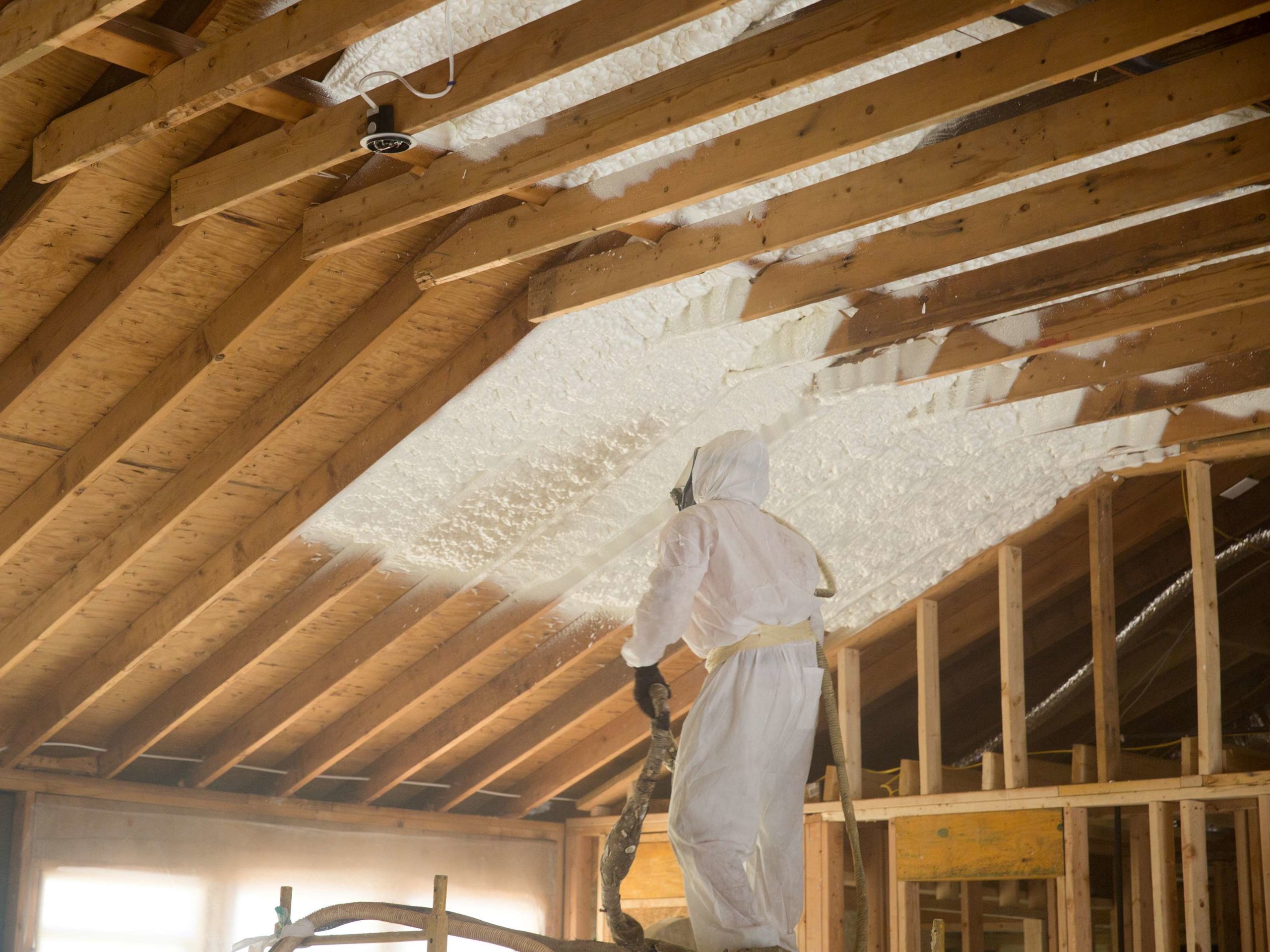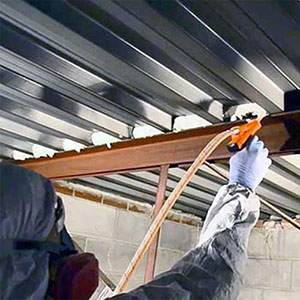Spray Foam: The Ultimate Option for Air Sealing and Insulation
Spray foam insulation has become a leading service for reliable air securing and thermal insulation, supplying an one-of-a-kind mix of properties that establish it aside from traditional techniques. Its capacity to increase and fill gaps makes it especially reliable in protecting against air leakage, which can substantially affect power effectiveness. Nevertheless, comprehending the full scope of its benefits, installation procedures, and comparisons with other insulation types is vital for making notified decisions. As we explore these facets, the effects for both new buildings and retrofits end up being progressively substantial. What factors should affect your option?
What Is Spray Foam?
Spray foam is a flexible insulation product that combines the principles of air sealing and thermal resistance to boost energy performance in buildings. Made up mostly of polyurethane or other similar substances, spray foam is used as a liquid that expands upon contact with surfaces, creating a strong, continual layer of insulation. This distinct residential or commercial property permits it to fill up voids, cracks, and gaps that typical insulation materials might overlook, giving a remarkable air seal.
There are two main kinds of spray foam: open-cell and closed-cell. Open-cell spray foam is lighter and much more adaptable, offering excellent audio absorption and a lower R-value per inch - Spray Foam. In contrast, closed-cell spray foam is denser, giving a greater R-value, wetness resistance, and added structural honesty to building elements
The application process typically involves specialized devices, guaranteeing a smooth application that sticks to different substrates, consisting of steel, concrete, and wood. This flexibility makes spray foam appropriate for both new constructions and retrofitting existing frameworks. Its capability to produce an impermeable barrier significantly contributes to minimizing power usage and boosting indoor air high quality, therefore making it a recommended choice amongst property owners and builders alike.
Advantages of Spray Foam Insulation
Among one of the most significant benefits of spray foam insulation is its remarkable ability to develop a continual air barrier, which efficiently minimizes energy loss. Unlike conventional insulation materials, spray foam increases to fill up fractures and voids, ensuring that air leakage is substantially decreased. This characteristic not only boosts energy efficiency yet additionally causes decrease energy expenses over time.
Furthermore, spray foam insulation supplies exceptional thermal resistance, adding to an extra stable interior environment. Its high R-value per inch permits efficient insulation in constrained spaces, making it excellent for attic rooms, walls, and crawl rooms. In addition, the moisture-resistant homes of spray foam help prevent mold and mildew and mildew growth, advertising much healthier living problems.
Another crucial benefit of spray foam insulation is its sound-dampening qualities (Spray Foam). It properly lowers sound transmission in between spaces, creating a quieter and a lot more comfy home atmosphere. The durability of spray foam likewise attracts attention, as it does not sag or resolve gradually, keeping its performance throughout its life expectancy
How Spray Foam Works
Comprehending just how spray foam insulation works is crucial for appreciating its efficiency in air securing and thermal resistance. Spray foam insulation includes 2 main elements: isocyanate and polyol resin. When these parts are combined, they go through a chemical reaction that triggers the product to increase rapidly, producing a thick foam that loads cavities, cracks, and spaces.
As the foam broadens, it abides by surface areas, creating an impermeable seal that dramatically lowers air infiltration. This characteristic makes spray foam insulation extremely efficient at protecting against drafts and dampness penetration, which can result in power loss and damages in time. Additionally, the closed-cell variant of spray foam uses superior thermal resistance because of its rigid framework, efficiently reducing heat transfer.
The unique homes of spray foam allow it to adapt uneven surfaces, making certain thorough coverage and a smooth barrier. Consequently, spray foam insulation not just enhances power performance yet additionally adds to boosted interior air high quality by reducing the accumulation of pollutants and allergens. Eventually, understanding the auto mechanics behind spray foam emphasizes its duty as a remarkable option for insulation and air sealing in both business and household applications.
Installment Process Introduction

Before installation, the room needs to be effectively cleaned and prepped, making sure that surface areas are devoid of dirt, particles, and moisture. Due to the fact that pollutants can endanger attachment and overall performance, this step is crucial. Once the area is prepared, the application includes mixing the two components of the spray foam, which expands upon contact and fills up gaps efficiently.
Educated experts ought to perform the installment, utilizing specialized tools to guarantee consistent insurance coverage and optimal thickness. Safety precautions, consisting of putting on safety gear and guaranteeing proper air flow, are vital during this procedure. After application, the foam commonly treatments promptly, forming a solid obstacle that boosts power efficiency.
Contrasting Spray Foam to Typical Insulation
When reviewing insulation choices, spray foam insulation stands apart in contrast to typical products such as fiberglass and cellulose. One of the main advantages of spray foam is its remarkable air securing abilities. Unlike fiberglass and cellulose, which can allow air infiltration, spray foam broadens upon application, filling spaces and gaps to create an impermeable seal. This leads to improved power effectiveness, as less heated or cooled air runs away the home, leading to reduced utility expenses.
In addition, spray foam gives a higher this content R-value per inch than conventional insulation kinds, using more reliable thermal resistance in a thinner account. This particular is particularly valuable precede with minimal cavity depth. Additionally, spray foam is immune to dampness and mold and mildew growth, which can be a substantial worry about cellulose and fiberglass, specifically in humid settings.
Nevertheless, spray foam insulation typically carries a greater ahead of time price than its traditional equivalents. Homeowners should weigh this initial financial investment versus long-lasting power financial savings and efficiency benefits. Ultimately, while both insulation types offer their objective, spray foam arises as an advanced solution for modern insulation needs, specifically in regards to air securing and thermal efficiency.

Final Thought
In summary, spray foam insulation stands for a very effective solution for achieving optimum air sealing and thermal resistance. Its distinct homes, consisting of moisture resistance and sound dampening, make it appropriate for about his numerous applications in both new constructions and retrofitting projects (Spray Foam). The first expenses might be higher compared to typical insulation products, the long-lasting advantages, such as considerable energy financial savings and improved interior air quality, warrant the financial investment and emphasize its worth in contemporary structure methods.
Spray foam insulation has actually arised as a leading option for effective air sealing and thermal insulation, supplying a special combination of properties that establish it apart from standard techniques.Spray foam is a flexible insulation material that integrates the concepts of air securing and thermal resistance to improve energy effectiveness in buildings.When reviewing insulation choices, spray foam insulation stands out in contrast to conventional products such as fiberglass and cellulose. Inevitably, while both insulation types offer their objective, spray foam emerges as a more sophisticated solution for contemporary insulation demands, specifically in terms of air sealing and thermal performance.
In recap, spray foam insulation stands for a highly efficient remedy for achieving ideal air sealing and thermal resistance.